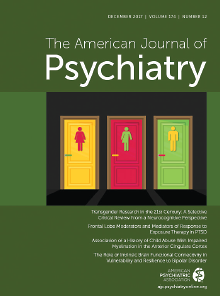The American Journal of Psychiatry received top recognition by New England Journal of Medicine (NEJM) Journal Watch Psychiatry and the Brain & Behavior Research Foundation (BBRF) last December for the publication of outstanding research that advances the clinical practice of psychiatry.
Two AJP articles were named “top stories of 2017” by NEJM Journal Watch Psychiatry, and four were listed as representing “top advances and breakthroughs” by BBRF. Psychiatric News Editor-in-Chief Jeffrey Borenstein, M.D., is president and CEO of BBRF.
One article—titled “Adjunctive Bright Light Therapy for Bipolar Depression: A Randomized, Double-Blind Placebo-Controlled Trial,” by Dorothy K. Sit, M.D., et al.—appeared on both lists.
“As we begin our 175th year of publication of the American Journal of Psychiatry, it is gratifying that our articles continue to be recognized by prominent institutions like the NEJM editors and BBRF,” AJP Editor Robert Freedman, M.D., told Psychiatric News. “Our scientific tools have advanced, our research scope has broadened, and our knowledge base continues to build. Yet we remain committed to publishing the articles that will help guide clinical practice now and in the future.”
Midday Light Therapy May Help Patients With Bipolar Depression
Treating patients with bipolar depression can be challenging, as antimanic medications often fail to reduce symptoms of depression in these patients and antidepressant monotherapy can induce hypomania and rapid cycling. Sit and colleagues wanted to know if midday light therapy might be able to help patients with bipolar depression without the risk of side effects.
In the article, published in October 2017, Sit and colleagues described how exposing patients with bipolar depression on stable antimanic medications to midday bright white light appeared to reduce depression scores after six weeks compared with those in the control group. Importantly, no hypomania, dramatic mood switching, or serious side effects were observed during the study.
“The novel use of a dose-titration protocol, implementation of bright light therapy at midday, and the requirement for concurrent antimanic treatment mitigated the risks for emergent mania or hypomania,” the authors wrote.
“Given its efficacy, ease of use, and tolerability, midday light therapy is ideally suited for depressed patients with bipolar disorder,” they concluded.
TD Medication Shows Promise
The other study named on NEJM Journal Watch Psychiatry’s Top 10 list was “KINECT 3: A Phase 3 Randomized, Double-Blind, Placebo-Controlled Trial of Valbenazine for Tardive Dyskinesia,” by Robert A. Hauser, M.D., M.B.A., et al.
Research shows that approximately 1 in 4 patients with chronic exposure to antipsychotics develops tardive dyskinesia (TD)—a condition marked by involuntary, repetitive body movements.
This study, published in March 2017, found that once-daily treatment with valbenazine at 80 mg/day significantly improved the symptoms of TD compared with placebo in a population of patients with schizophrenia, schizoaffective disorder, or a mood disorder. The medication was generally well tolerated, even among patients taking concomitant antipsychotics, and the psychiatric status of the patients remained stable throughout the trial.
Less than one month after the article appeared in AJP, the Food and Drug Administration (FDA) announced the approval of valbenazine (Ingrezza) capsules for the treatment of adults with tardive dyskinesia (TD). The medication, a novel and highly selective vesicular monoamine transporter 2 (VMAT2) inhibitor, became the first FDA-approved product for TD.
BBRF Recognizes AJP’s Publication of Breakthroughs by Grantees
In addition to the article by Sit and colleagues referenced above, the following studies were selected by BBRF in its list of the top advancements and breakthroughs by its grantees in 2017 (in chronological order):
•
“Effect of a Novel NMDA Receptor Modulator, Rapastinel (Formerly GLYX-13), in OCD: Proof of Concept,” by Carolyn I. Rodriguez, M.D., Ph.D., et al. (December 2016)
Intravenous administration of rapastinel may rapidly decrease symptoms of obsessive-compulsive disorder without harmful side effects, this small, open-label trial found.
Seven patients with OCD received a single 3- to 5-minute intravenous dose of 10 mg/kg rapastinel before rating the severity of their obsessions and compulsions, anxiety, and depression at 90 minutes and 230 minutes after infusion.
Compared with baseline symptoms, the patients reported significantly lower scores on all three psychiatric domains (obsessions, anxiety, and depression) at the 90- and 230-minute time points. Dissociation, mania, and psychosis were not significantly changed from baseline, and participants did not report adverse events like dizziness, nausea, or headache. An independent evaluation of the patients one week later found that these acute improvements were not sustained, as no patient met the criteria for treatment response.
“To have clinical utility, glutamate modulators should refine molecular targets for rapid and sustained action while minimizing side effects,” the authors concluded. “Mechanistic preclinical data suggest drugs like rapastinel and ketamine’s metabolite hydroxynorketamine that act on AMPA receptor modulation pathways may be promising therapeutic strategies.”
•
“Multimodal Neuroimaging of Frontolimbic Structure and Function Associated With Suicide Attempts in Adolescents and Young Adults With Bipolar Disorder,” by Jennifer A.Y. Johnston, M.A., et al. (January 2017)
Relying on multiple MRI techniques, the authors of this study compared the brain images of 26 adolescents and young adults with bipolar disorder (BD) who had a prior suicide attempt with 42 controls without a suicide attempt. The authors observed that, compared with nonattempters, those who had made a suicide attempt had significant reductions in both gray matter and white matter integrity, as well as less functional connectivity between the amygdala and regions of the prefrontal cortex.
Further analysis found that among attempters, lower connectivity to the right rostral prefrontal cortex was associated with more severe suicidal ideation, while lower connectivity to the left ventral prefrontal cortex was associated with higher attempt lethality.
“Integrated study of brain structure and function, and their associations with symptoms and behavior, in suicide research is important in elucidating risk mechanisms that may involve complex, parallel, and interacting relationships between developing circuitry and symptoms and behaviors,” the authors wrote.
•
“The Effect of a Single Dose of Intravenous Ketamine on Suicidal Ideation: A Systematic Review and Individual Participant Data Meta-Analysis,” by Samuel T. Wilkinson, M.D., et al. (October 2017)
A single infusion of ketamine appears to rapidly reduce suicidal thoughts in depressed patients with benefits lasting for up to one week, according to this meta-analysis. Data on 167 patients with suicidal ideation at baseline of a ketamine trial were included in the analysis.
Wilkinson and colleagues found that ketamine reduced suicidal ideation more rapidly than was observed with the control treatments on the Montgomery-Åsberg Depression Scale and the Hamilton Depression Scale, as well as on patient self-reports. Significant benefits appeared as early as day 1 after treatment and extended up to day 7.
“Notably, after controlling for improvement in severity of depressive symptoms, ketamine’s effects on suicidal ideation remained significant,” the authors wrote. “This suggests that ketamine has a specific effect on suicidal ideation that depends only partly on change in overall severity of depressive symptoms.” ■
The
NEJM Journal Watch Psychiatry Top Stories of 2017” can be accessed
here. The Brain & Behavior Research Foundation’s “Top 10 Advancements and Breakthroughs by Foundation Grantees” is available
here.

